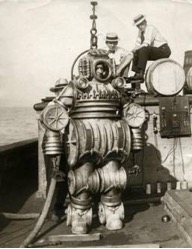
The barge Nelson Bloom’s passing through the familiar waters of Thunder Bay, Lake Huron offered an almost silent and solemn homage to her long-lost sister ship whose remains lay dormant in the waters far below. Forty-seven years earlier, while plying the same waters, the Nelson Bloom, serving as a passenger steamer named S.S. Meteor, had been involved in a deadly collision with her sister ship the S.S. Pewabic. One hundred and twenty-five lives had been lost in the awful conflagration that occurred on the night of August 9, 1865. Now, as the Nelson Bloom entered the twilight of her time on the waters of Lake Huron, it was almost as if her sister was offering an ominous and eerily alluring call to those who were brave and bold enough to explore her underwater cemetery. Bobbing above the bones of the wreck, on the rough waters of Thunder Bay, Captain Enos B. Petrie was one such man. He leaned over and spoke into the communications box telephone. As much as it pained him to do, he passed on the orders to his diver located one hundred and eighty feet below the keel of the salvage steamer Douglas to prepare to ascend from the wreckage. The serene waters had turned into an almost melancholy mess of waves and whitecaps. The quest to pilfer the S.S. Pewabic’s cargo of copper would have to wait for a return dive. The underwater grave of the ill-fated steamer was to remain untouched that day. The Iron Man was ordered to return to the surface.

Five years earlier, in 1907, Captain Petrie gathered the newspaper men and several investors onto the deck of the barge, Mary H. Brainard. The Maria Hoffman had towed the barge into a position above the dizzyingly deep hole in the waters off of Eaton’s Neck Point, New York in the Long Island Sound. The leader of the expedition, Captain Petrie, a veteran tug boat captain and marine salvager, introduced the man who would don the diving suit of his and colleague Joseph E. Martin’s creation – the Iron Man. The young man, O.E. Gaudy stood aside the metal contraption that he would soon don and dive, hopefully successfully, into history. The four hundred and fifty-pound metal diving suit had proven successful in pressurized testing and now the day had come to put it under the waves and confirm its capabilities. As Captain Petrie explained how the suit was constructed and how it operated, Gaudy stood aside the equipment clothed only in a pair of dark blue long-johns. Gaudy, an employee of the U.S. Navy Yard in Brooklyn, had volunteered to take part in the deep-sea expedition. While not a professional deep-sea diver, he had served as an engineer for four years aboard the Shark, an early U.S. Navy submarine, and was confident in the construction of the diving equipment. With questions answered for the bevy of journalists and as the potential investors kept a keen eye on the diving equipment, Captain Petrie and his assistant, deep-sea diver Emanuel Johnson began assisting Gaudy into the Iron Man suit.
With the helmet screwed into the suit, Captain Petrie and his assistant began attaching the arms of the suit to the torso sections. With the arms secured, the two handpieces or grabbers were inserted and tightened. With the upper torso and appendages fastened, the men attached the legs of the suit. With the warmth of the sun beating down on the Iron Man suit all day aboard the barge, Gaudy began sweating profusely. Captain Petrie took a rag out of his pocket and reached into the helmet to dry Gaudy’s brow. Gaudy offered a quiet thank you and then Captain Petrie secured the faceplate to the helmet. Compressed air began pumping into the suit, Gaudy slowly raised the metallic arm of the suit to acknowledge his freedom of mobility. Gaudy’s voice then boomed through the speaker of the squawk box located aboard the barge. Captain Petrie and Emmanuel Johnson made one last inspection of the suit as Gaudy spoke to the excited journalists. The test was about to begin. With the lead line hoisted aboard the barge, all aboard agreed that the depth of the hole was at two hundred and four feet. The Iron Man, added with ninety pounds of additional lead around the legs, was hoisted off of the deck of the barge and swung carefully out over the calm waters of the Long Island Sound. The time was 4:17. The Iron Man began to be lowered under the surface of the smooth waters.
Gaudy’s voice echoed through the squawk box speaker aboard the barge as he continued his descent into the abyss. Within moments, Gaudy reported a depth of sixty feet and that all was well. The Iron Man’s tethering cable, a mixture of electric power, telephone cables, and its airline providing compressed air, continued to snake from the reel aboard the barge into the darkened depths. One hundred feet was quickly attained as the Iron Man continued on its downward plunge. At one hundred and fifty feet, Gaudy reported that he struck the muddy bottom of the Long Island Sound. The men aboard the barge shouted in excitement and congratulated each other with hearty handshakes. Gaudy reported that he felt as “fine as silk” and answered questions from the journalists. Though the two electric searchlights on the diving suit had failed to work at the depths due to dynamo trouble, Gaudy reported some flickers of light about his face mask and noted that it must have been from the illuminated phosphorescent sea life lurking in the silty shadows of the Sound. Gaudy spoke lively and quickly and reported that he was able to trudge around on the muddy bottom with ease. After a few minutes on the bottom, Captain Petrie alerted Gaudy to prepare to surface. The goal had been ascertained. Captain Petrie and his Iron Man suit had attained a new depth record.
The hoist aboard the barge began to quickly reel in the lifeline of the Iron Man’s suit. As the cable continued snaking back aboard from the shimmering surface of the Sound, the shiny metal helmet of the suit finally broached the surface. Carefully hoisted back to the deck of the barge, Captain Petrie quickly removed the faceplate. Gaudy took in a deep breath of fresh air as some of the newspaper men grabbed at the oozed mud that was caked on the legs of the suit as a smelly souvenir of the intrepid exploration into the depths. The final agreed upon depth had been two hundred and four feet. Though Gaudy asked to go down again into the murky waters of the Long Island Sound, Captain Petrie and the others aboard decided to call it a day. As the journalists and potential investors headed back to Brooklyn, Captain Petrie asked the reporters to only write what they had personally witnessed – a successful dive into the deep in the Iron Man equipment. For the potential investors though, Captain Petrie had a much broader message that encapsulated his dreams of salvaging opportunities.
Captain Petrie expounded upon the potential utilization of the Iron Man diving suit that had now been proven capable of exploring previously unattainable depths to recover the countless tolls of treasure that littered the depths of the World’s watery domains. The investors listened but none, according to available reports, ever materialized to financially support Captain Petrie’s dreams. For Captain Petrie, no was not the answer. Five years later, aboard his salvage scow, Captain Petrie and his dozen men pulled the Iron Man back aboard from her voyage to the sunken bones of the S.S. Pewabic. As waves crashed against the beaten boards of the Douglas, he slumped down onto a seat in the wheelhouse over a cup of hot coffee and closed his eyes. His dreams of pulling the copper treasure from the cargo hold of the S.S. Pewabic remained but a dream.
In October of 1917, deep-sea diver Captain Benjamin F. Leavitt successfully pulled a bounty of copper ingots from the bowels of the S.S. Pewabic, using both a deep-sea diving suit of his design and a clam-digger method. Captain Petrie and his Iron Man diving suit designs faded into the abyss of history and little is known of the final efforts or life of the intrepid dreamer or the Iron Man diving equipment. While lost to the annals of antiquity, one fact remains clear. On August 22, 1907, Captain Petrie’s Iron Man was lowered through the murkiness to depths of over two hundred feet and into the history books in our waters.
Sources:
Hartmeyer, Philip A. “Passengers, Packages, and Copper: The Steamer Pewabic, Its Archeology, Management, Material Culture, and the Development of the Keweena Peninsula.” May 2014.
The Alpena News.
“Title Unknown,” August 7, 1965.
The Brooklyn Daily Eagle.
“Diver Reaches Depth of 230 Feet,” August 23, 1907.
“All Diving Records Broken Yesterday,” August 23, 1907.
The Butte Daily Post.
“Man Renews Buried Treasure Quest in Thunder Bay Where Copper Lost 50 Years ago is Raised,” August 27, 1917.
The Cheboygan Daily Tribune.
“Curse of the Copper,” September 9, 2011.
The Daily Leader.
“The Pewabic Disaster,” September 4, 1865.
The Duluth Herald.
“Trying to Recover Valuable Cargo,” July 22, 1912.
The New York Times.
“The Disaster on Lake Huron,” August 14, 1865.
“Raising the Pewabic’s Cargo,” October 1, 1897.
The Pleasantville Press.
“Divers Get to Treasure Ship After Years of Vain Effort,” August 4, 1917.
The Portland Daily Press.
“Untitled,” December 24, 1894.
The Sierra County Advocate.
“Sunken Treasure,” January 18, 1895.
The Wheeling Daily Register.
“From Detroit – A Disaster on Lake Huron,” August 12, 1865.
Vorosmarti, James. “Petrie-Martin 1 ATA Diving Apparatus.” The Journal of Diving History. Volume 23, Number 84, 2015.
